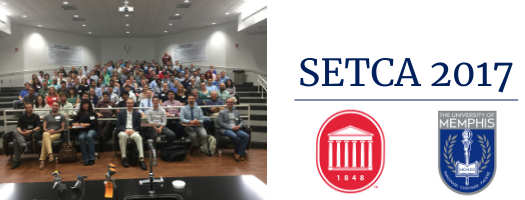Location
Coulter Hall, Room 211
Start Date
19-5-2017 2:40 PM
Description
The mechanisms of phosphoryl transfer enzymes have garnered considerable attention. Fluoro-containing metal species have been used as transition-state and ground-state analogues in a variety of phosphoryl transfer enzymes and have shed light on the nature of the requirements in the active site to catalyze phosphoryl transfer. Some of our work on phospholipase D (PLD), tyrosyl-DNA phosphodiesterase I (Tdp1), human histidine triad nucleotide binding protein 1 (hHINT1), fructose-1,6-bisphosphatase (FBP), cyclic adenosine monophosphate dependent protein kinase (cAPK), and β-phosphoglucomutase (β-PGM) will be discussed.
- Charles Edwin Webster, Mississippi State University
- Guangchao Liang, Mississippi State University
- Robert W. Lamb, Mississippi State University
- Katherine N. Leigh, University of Memphis
- Roger G. Letterman, University of Memphis
- Nathan J. DeYonker, University of Memphis
Relational Format
Conference proceeding
Recommended Citation
Webster, Charles Edwin, "IL7. Theoretical studies of phosphoryl transfer enzymes" (2017). Southeast Theoretical Chemistry Association Meeting (SETCA). 15.
https://egrove.olemiss.edu/setca/2017/schedule/15
IL7. Theoretical studies of phosphoryl transfer enzymes
Coulter Hall, Room 211
The mechanisms of phosphoryl transfer enzymes have garnered considerable attention. Fluoro-containing metal species have been used as transition-state and ground-state analogues in a variety of phosphoryl transfer enzymes and have shed light on the nature of the requirements in the active site to catalyze phosphoryl transfer. Some of our work on phospholipase D (PLD), tyrosyl-DNA phosphodiesterase I (Tdp1), human histidine triad nucleotide binding protein 1 (hHINT1), fructose-1,6-bisphosphatase (FBP), cyclic adenosine monophosphate dependent protein kinase (cAPK), and β-phosphoglucomutase (β-PGM) will be discussed.
- Charles Edwin Webster, Mississippi State University
- Guangchao Liang, Mississippi State University
- Robert W. Lamb, Mississippi State University
- Katherine N. Leigh, University of Memphis
- Roger G. Letterman, University of Memphis
- Nathan J. DeYonker, University of Memphis



Comments
Download includes an expanded abstract with collaborators, institutional affiliations and cited references.